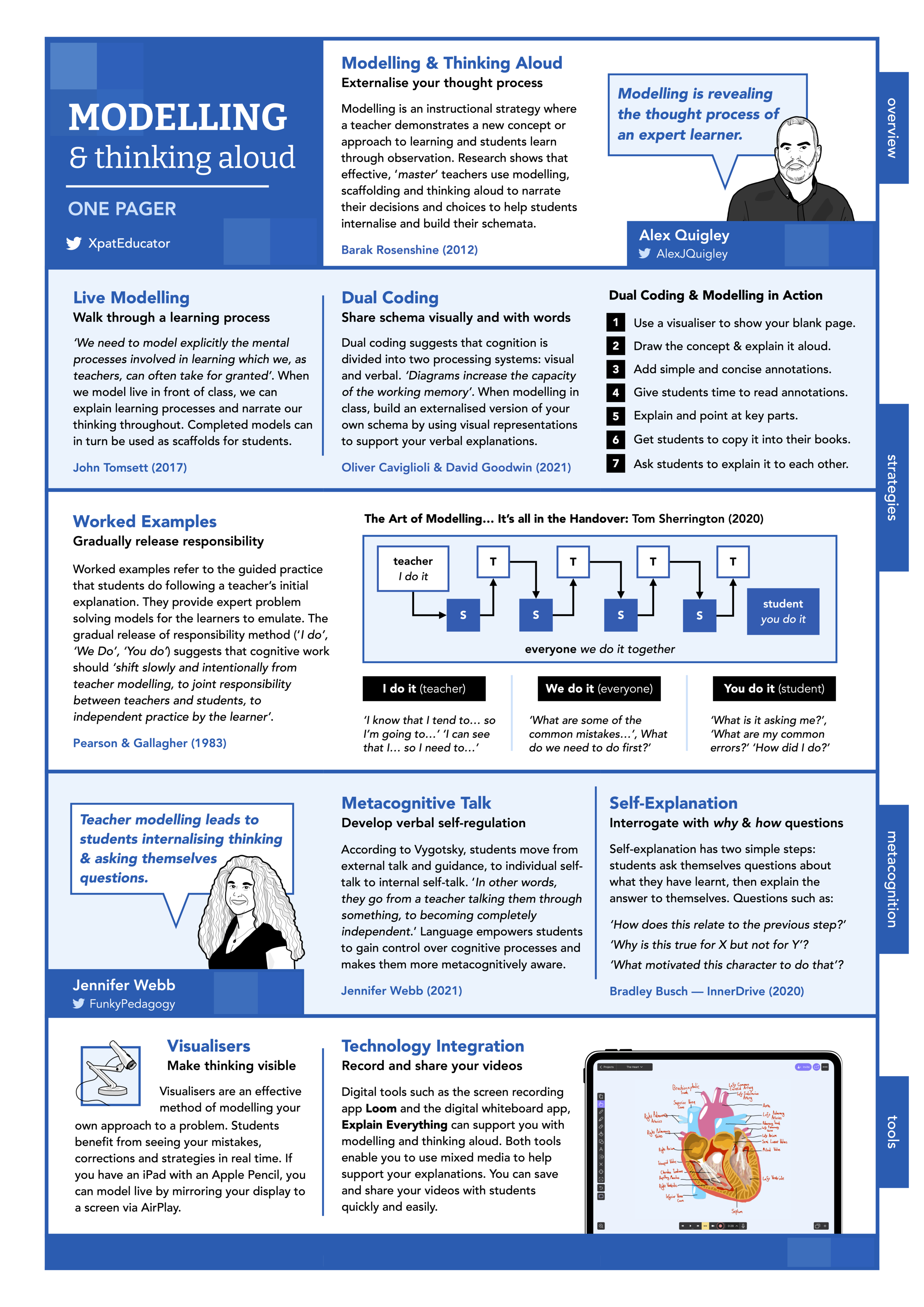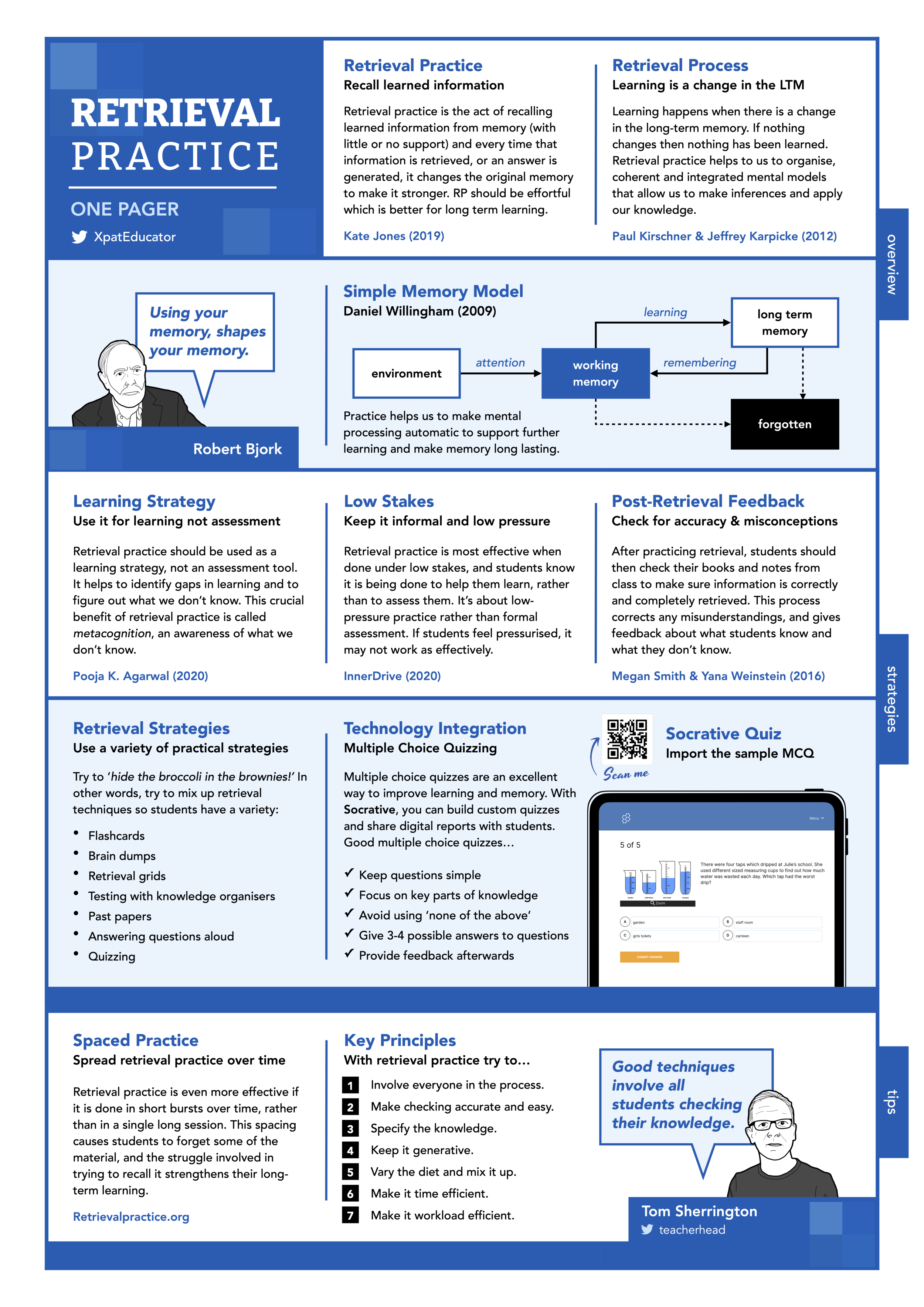One-Pagers: Teaching Summaries
As CPD coodinator at my school, I wanted a simple way for busy teachers to engage with evidence based practice and share ideas about good teaching. One-pagers are practical, bite-sized A4 summaries of context-free teaching strategies that help educators reflect on their practice and check their knowledge and understanding.
As CPD coodinator at my school, I wanted a simple way for busy teachers to engage with evidence based practice and share ideas about good teaching. One-pagers are practical, bite-sized A4 summaries of context-free teaching strategies that help educators reflect on their practice and check their knowledge and understanding.
I have had a lots of positive feedback from teachers on Twitter who love the A4 format as it is accessible and succinct. The grid layout and design (clearly inspired by the brilliant Oliver Caviglioli) helps to break down and categorise information so it is easy to read and process. I included a range of educational voices who have inspired my own practice over the years — many of these educators I follow on Twitter and have a solid reputation sharing evidence based ideas. One of which, Tom Sherrington hit the nail on the head in his tweet explaining my one-pager:
Summary 1: Feedback
This is the new and updated feedback one-pager. As you can see, Dylan Wiliam’s work underpins the information on this summary. However, it now includes actionable feedback strategies (Tom Sherrington); whole class feedback (Andrew Atherton) and a peer feedback section based on Ron Berger’s ‘kind, specific and helpful’ approach.
Summary 2: Modelling & Thinking Aloud
This summary was originally going to be on metacognition. However, I decided to keep the one-page format practical and teacher focused rather than just breaking down heavy research. As a result, I interspersed critical points about metacognition and how it relates to modelling and thinking aloud process.
Summary 3: Retrieval Practice
I use retrieval practice strategies all of the time in my own teaching. This summary offers a whole heap of ideas and reminders. Originally, I made a mistake by indlcuding the (out-dated), ‘Multi-store Model of Memory’ diagram. After some brilliant feedback on Twitter, I quickly changed this to Daniel Willingham’s ‘Simple Memory Model’. Much better!
Request a One-Pager
Have an idea for a great one-pager? Please feel free to get in touch on Twitter or leave a comment below.
Download
If you are going to share the ‘One-pager: Teaching Summaries’ PDF online or in your school, please credit me - Jamie Clark (@XpatEducator). Thanks for the amazing response and keep a look out for more one-pagers coming soon!
Episode 10: Retrieval Practice Pooja K. Agarwal, Ph.D.
In this exciting episode of The Staffroom, we spoke about retrieval practice with Pooja K. Agarwal, Ph.D. (@PoojaAgarwal) an expert in the field of cognitive science. Pooja is the Founder of RetrievalPractice.org, a hub of research, resources, and teaching strategies based on the science of learning. Listen for her practical tips and ideas on the most powerful learning strategy - retrieval practice!
The Staffroom Show Notes
In this exciting episode of 'The Staffroom', we spoke about retrieval practicewith Pooja K. Agarwal, Ph.D. (@PoojaAgarwal) an expert in the field of cognitive science. Pooja is the Founder of RetrievalPractice.org, a hub of research, resources, and teaching strategies based on the science of learning – check this out!
Pooja’s work is being noticed more and more by teachers around the world as she offers practical tips and advice on cognitive psychological research and strategies can enhance and accelerate student learning.
Here’s our conversation with Pooja broken down with time-stamps:
Who is Pooja and how did she get involved with cognitive science? (3:35)
How does Pooja define retrieval practiceand why is it a powerful strategy for learning? (5:50)
What examples does Pooja use to illustrate retrieval practicein the classroom? (7:50)
Does Pooja think that it is difficult to engage students in retrieval practicestrategies? Why does she think it is important to keep retrieval practiceas a low or no-stakes approach? (9:40)
Does Pooja believe retrieval practiceworks better with older or younger students? (11:45)
How can educators implement retrieval practiceinto their teaching? What techniques does Pooja suggest are most effective? (13:20)
Why does Pooja believe that feedback is an important part in retrieval practiceprocess? (16:50)
Does Pooja think that there are any potential challenges for teachers when implementing retrieval practice? Does she believe it impacts on workload? (19:50)
What is Pooja’s upcoming book called and what’s it about? (22:15)
We hope you enjoy this episode of The Staffroom and found Pooja’s ideas on retrieval practice strategies as fascinating as we did. We gathered lots of practical tips and tricks on how to work smarter not harder – remember: retrieval practice is one of the most powerful strategies to use in your classroom – why not give it a go?
We wish Dr Pooja K. Agarwal all the best for 2018 and her continuing success of RetrievalPractice.org. Remember to buy her book once it’s released in June next year!
Until next time!
Jamie, Michael and Tessa
Twitter:
Episode 9: The Science of Sketch-noting Oliver Caviglioli
In this episode, we were lucky enough to speak to Oliver Caviglioli about the power of learning visuals and its basis in cognitive psychology. Oliver (@olicav) is an information designer who is widely known as an expert in visualising educational concepts. In recent years, he has worked with lots of different teacher-authors in illustrating their books.
The Staffroom Show Notes
‘The Staffroom’ is back! In the first episode of Series 2, we were lucky enough to speak to Oliver Caviglioli about the power of learning visuals and its basis in cognitive psychology. Oliver (@olicav) is an information designer who is widely known as an expert in visualising educational concepts. In recent years, he has worked with lots of different teacher-authors in illustrating their books.
Our chat with Oliver gave us some real insight into the use of visuals (such as sketch-noting) to conceptualise, categorise and organise information to enhance learning.
Here’s a break-down of our chat complete with time-stamps:
How did Oliver’s background and interest in ‘behaviourism’ influence his work as an information designer? (4:04)
Why does Oliver believe his visuals are becoming more and more popular with educators around the world? (6:07)
Why does Oliver think sketch-noting should not be ‘artistic’ and individualised? Why does he believe it is important to keep it simple? (8:30)
Why does Oliver think that all teachers should know about cognitive psychology? (10:09)
Why does Oliver believe it is important for teachers to use a balance of cognitive psychological research and educational research? (12:15)
What is ‘precis’ and why is it an important way of learning? Why does Oliver think that summarising/sketch-noting is an effective method of learning? (12:49)
Who is Ruth Colvin Clark and what does she say about decorative visuals and explanatory visuals? (14:29)
What is the main tip Oliver gives to people who want advice about their sketch-notes? (16:08)
How does Oliver think teachers should practice sketch-noting effectively with students? (16:50)
Is Oliver an advocate of technology to support and accelerate learning? (20:20)
If Oliver could recommend one professional learning book to a new teacher, what would it be and why? (20:35)
Where can people find Oliver’s work online? Where are his books available to buy? (24:01)
If you’d like further information about Oliver, you can check-out his work with Dr Megan Sumeracki (@DrSumeracki) and Dr Yana Weinstein who are the creators of The Learning Scientists project. Their book is called ‘Understanding How We Learn: A Visual Guide’ – check this out now! Also, if you're interested in our colleagues' Apple book on 'The Science of Sketch'-noting, take a look at Jamie Clark and Daniel Budd's digital book here.
We hope you enjoy this episode of The Staffroom and found Oliver’s words as fascinating as we did. We can’t wait to make sketch-noting and informational design part of our practice!
Until next time!
Jamie, Michael and Tessa
Twitter:













